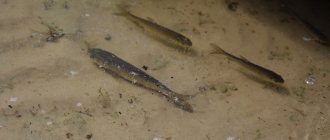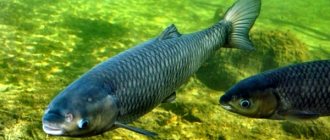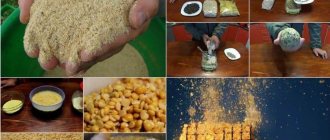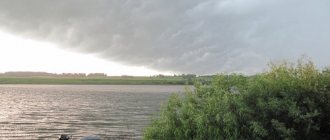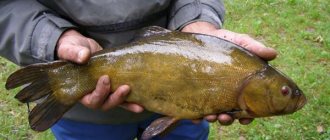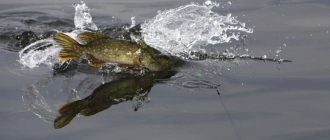Grass carp is a herbivorous fish from the carp family, as well as the only representative of its genus. This breed is highly valued by many fishermen due to its not only tasty, but also healthy meat, which contains a large amount of various vitamins and beneficial nutrients. Catching this fish can be done in different ways, all of them have their own specific features, features that will be discussed in detail in this article.
Equipment
You can catch grass carp using a variety of gear, all of which can show good efficiency in certain situations and provide a decent catch. First of all, it is necessary to consider the features of this process; if the choice fell on the donka, its equipment will look like this:
- Sinkers are not used; instead, you will need to hammer the hominy into the spring; its weight is selected in such a way that it allows casting to the required distance.
- The hook is equipped with a hair attachment; corn kernels and small foam balls can be used as bait. In this case, before starting fishing, the behavior of the hook when immersed in water is checked: if it sinks, then it is necessary to reduce the weight of the bait used.
- It is not necessary to use specialized carp hooks, since they are quite large and require a large amount of foam to disguise them. For catching grass carp, hooks made of thin, hardened wire, which are very often used for boilie equipment, are quite suitable.
- All baits must be put directly on the hook, because otherwise the prey often does not reach it, sucking only the hair equipment into the mouth, which increases the number of fish escapes during hookings.
It is also very common to catch grass carp using float gear; the most effective are massive carp models. Bolognese or fly fishing rods usually do not have good catchability, so most anglers choose match rods or plugs.
General equipment requirements are given below:
- The maximum diameter of the working line is 0.25-0.3 mm, and it must be of good quality and with a high elasticity index to withstand the resistance of strong prey.
- A leash is required; usually its diameter is 0.2-0.25 mm, depending on the thickness of the working line.
- Hooks are used from No. 8 to No. 12, the choice depends on the size of the intended prey, fishing conditions, as well as the diameter of the fishing line used.
- The rod can be virtually anything; models with a classic action are suitable, but you will need to abandon ultra-light and lightweight options.
- The rod model can be virtually any with a standard action, but you will need to abandon the ultra-light and lightweight options. The selected tackle should have a sufficient level of sensitivity so that even the lightest bites can be felt.
Bait for catching grass carp
To guarantee the attraction of grass carp, it is recommended to prepare a bait mixture from contrasting and nutritious ingredients of large fractions. Various flavoring and aromatic substances added in moderation will significantly increase the chances of a good catch.
To prepare high-quality bait, use corn grains, pea dough, a mixture of boiled corn, green peas, sunflower cake and chopped young cucumbers. You can also add parts of the bait you use.
Recommendations:
- In order not to scare away the fish at the beginning of fishing, do not immediately throw the bait mixture;
- the use of granules in bait does not give the desired result, it is better to add bulk components;
- You can increase the effectiveness of bait by using all kinds of sprays, for example, with the smell of freshly cut grass;
- In a new place, it is recommended to experiment with baits and periodically feed the fish;
- high-quality bait will form an attractive column of turbidity;
- Diluting bait with soil is not effective.
Lures and bait
Grass carp have a fairly extensive diet, allowing anglers to choose from a wide variety of baits. It is recommended to have a whole range of different options with you, which will allow you to select the desired variety directly at the fishing site, after the preferences of the prey living in a particular body of water become known. The most commonly used attachments are:
- Corn, and it can be either fresh or boiled, the only requirement is the absence of strong-smelling flavors that can scare off potential prey with their aroma.
- Young cucumbers can be used as an independent bait or an additional component in the manufacture of mixtures that are used both as bait and complementary food.
- Maggots or worms are also often good at attracting the attention of grass carp, although he prefers food of plant origin. Such baits are most often used during fishing in cool temperatures or periods when this breed begins to actively feed.
- Dough, but it is necessary to add any plant ingredients to it, otherwise the fish may ignore such bait.
- Succulent plants virtually always attract grass carp, since they form the basis of their diet in their natural habitat. Fresh stems of reeds or reeds, pea leaves, and clover are best suited.
- Bait in the form of granules, which is purchased in fishing stores. It is recommended to discard all generic options, as they usually demonstrate a low degree of effectiveness. More effective are specialized mixtures designed for catching representatives of the carp family.
How and what to feed?
The use of bait mixtures greatly increases fishing efficiency. Experienced fishermen advise preparing your own complementary food, which can create muddy columns in a pond, which attracts prey even from the longest distances. To do this, you can use the following recipe:
- Typical bait and groundbait for White Amur
The basis is a mixture of mixed feed or cake. - Mix dry milk in equal proportions; crushed and finely crumbled cookies; any type of bread; semolina. All of these ingredients will make up the base that is added to the base and is needed to create a cloudy cloud in the water.
- Components with a sufficiently large fraction are added. Grass carp responds best to peas, corn or pearl barley. You can also use boilies, which are added either to the bait mixture or poured into the water directly at the fishing site.
- To add a sweet taste to the bait, which is very attractive to prey, you can use any type of honey, flavored oils or condensed milk as additional components.
- A good addition is garlic, which is recommended to be added to mixtures prepared according to any recipe. To do this, it must be finely grated and mixed with the main mass until a homogeneous consistency is obtained.
There is another recipe for complementary feeding, which is very often used when catching grass carp using float rods. Its main advantages are the availability and low cost of all ingredients, as well as the simplicity of the preparation technology; detailed instructions are given below:
- First you need to boil the millet, which is then mixed with several standard packs of store-bought bait mixture designed for carp or crucian carp.
- One loaf of black bread, well soaked in water, and a glass of steamed cake are added to the resulting mixture.
- A few bananas and a handful of corn are added, after which the mixture is thoroughly mixed until smooth.
- The resulting thick mixture is necessary for sculpting bait balls; the recommended size should be no larger than a regular orange.
The last recipe is designed to prepare a mixture with a more viscous structure, which makes it ideal for driving into a spring if fishing with bottom tackle. A detailed algorithm of actions is given below:
- Semolina
Initially, you will need to prepare jacket potatoes and cook semolina porridge. - Potatoes are grated, but these two components should not be mixed at home, but exclusively while fishing.
- Additional ingredients will be required; they should be added strictly in the following order: black bread crumb, several bananas, steamed cake, corn.
- The mixture must be thoroughly mixed, after which you will need to check its consistency. If it is not viscous enough, this indicator can be increased by adding semolina until the required structure is obtained. After this, the bait will be completely ready for hammering into the spring and casting into the pond.
When using any bait mixtures, you must be guided by two basic rules: Do not immediately use up all the bait at once, since it can be useful for supplementing the area, which allows you to keep already attracted fish in the immediate vicinity. Feeding a place should be carried out in reasonable and moderate quantities, since the main goal of such manipulations is only to attract fish to the required place. Otherwise, there is a risk of overfeeding it, after which the prey will stop responding to the bait being thrown.
Catching grass carp with young cucumbers
Young cucumbers are considered one of the favorite delicacies of grass carp. They should be fresh, but it is better to avoid old and yellow cucumbers, given their bitter and old taste.
Rules for fishing for young cucumbers:
- Young cucumber ovaries must be cut into cubes and sent to a pond. Cupid shows particular interest in cucumbers with yellow flowers.
- It is also effective to use the green skin of a fresh cucumber as bait . It must be cut into long strips up to 5 cm and put on a hook.
- use poppy seed or corn as bait , but you shouldn’t expect great results. If you use them for bait, you can greatly attract fish to the fishing area. By the way, corn kernels can also be used raw. A bait mixture of macadamia, corn grains and cubes of young cucumbers is an ideal mixture for catching large carp.
- A cube of young fresh cucumber placed on a hook and slightly raised from the bottom can provoke prey to take active action and capture the bait.
Fishing at different times of the year
Changes in the weather greatly affect the behavior and appetite of grass carp, so fishing in different seasons has fundamental differences. All the nuances of this process are discussed below.
Winter
In winter, catching grass carp is practically never practiced, since this breed is characterized by increased heat-loving behavior. As soon as the temperature in the reservoir drops below +10-13°C, the fish experience a sharp loss of appetite, which is why there are no bites at all.
Spring
The fishing season resumes in the spring; its start depends on the climatic conditions of the region where fishing takes place. Most often, the bite resumes no earlier than mid-April or early May. There is no need to additionally feed grass carp, since after winter it is quite active and has a good appetite; the best bait at this time will be any suitable fresh vegetation. It is recommended to choose shallow water as a place for fishing, as it warms up much faster.
Summer
The summer period is a very good time for hunting grass carp, since already in the first days of June its activity increases, which has a positive effect on the bite. A significant improvement in conditions and temperature conditions in the habitat leads to the fact that the fish begins to experience hunger, so virtually all types of bait are effective, and additional feeding is not required. A stable bite will be observed until the water warms up to +25 °C, since after this the grass carp begins spawning.
Autumn
Catching grass carp in the fall is much more difficult, so only fairly experienced anglers go fishing at this time of year. This is due to the impossibility of predicting the bite, since it is directly dependent on the amount of precipitation (for example, if you chose a lake), changes in temperature conditions and other weather features.
If at the beginning of autumn the weather remains relatively warm and sunny, then the summer bite remains, however, with the predominance of cloudy and rainy days, the prey begins to behave more passively. This is due to the fact that the fish senses the approaching cold weather and begins to prepare for winter, but in most cases the likelihood of successful fishing remains until mid-October. After this, attempts can be stopped, since grass carp will try to stay close to the bottom surface and be in a sleepy state.
Tips for beginners
The basic principles and features of catching grass carp were discussed in detail in the article; to summarize, we can give the following recommendations that may be useful to novice fishermen:
- Sinkers and float are often undesirable elements, since grass carp are shy. Most fishermen watch for bites with the help of properly selected and adjusted gear, but beginners who do not yet have this skill can use bells, which will signal the beginning of a bite.
- The smell of a person is very undesirable because it can also scare fish. For this reason, it is necessary to hold your hands in the pond for some time, and only then touch the bait or bait with them.
- When fishing, it is not recommended to constantly be in close proximity to water, since grass carp may notice a person and begin to show increased caution. It is best to hide in the coastal thickets, having previously installed a fishing rod nearby. It is important not to make noise, since this breed of fish has fairly good hearing.
- Grass carp is a very strong prey animal that prefers to resist. For this reason, all hooks made must be confident, and the fish must be pulled quickly, but it is also important to maintain balance, since too strong jerks on both sides can lead to the line breaking.
- Grass carp is not only a strong, but also a very hardy fish, so hooking should begin after the first signals of a bite. The main task of the fisherman is to fish the prey to the shore as quickly as possible, but at the same time one must not forget about caution. The main thing is not to allow any grass carp you come across to go into the thicket of vegetation, since even the most experienced fishermen may not be able to pull it out of such a place.
- The bait can be additionally secured with threads; this measure is necessary so that the fish immediately falls on the hook tip, but its camouflage is not damaged.
What do grass carp bite on in summer?
- In June, hunting for grass carp becomes an ineffective activity, and there is a certain decline in fish bites. To attract fish you will need to put in a little effort: prepare a lot of corn bait, experiment with baits. The biting becomes more active in hot weather - midday.
- In July, the fish are attacked by zhor, the bites are stable. A good bite is observed after the summer heat subsides - from evening to dawn. It is recommended to feed constantly. Fishing for carp requires maximum caution and patience. In cloudy weather, fish should be caught in the coastal zone overgrown with reeds.
Here you can see what the carp are biting on.

